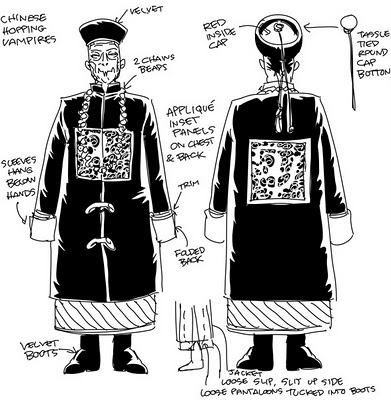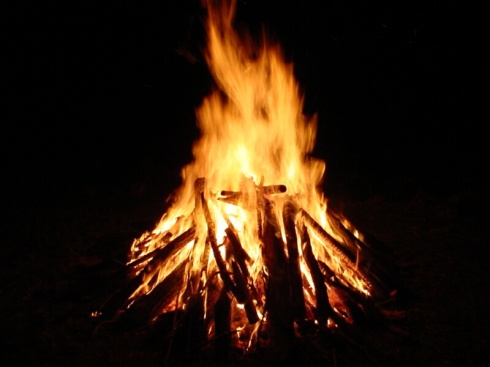You are currently browsing the tag archive for the ‘undead’ tag.

Namorodo Spirit (Mick Kubaku, 1971, earth pigments on eucalyptus bark)
Ferrebeekeeper has not written about the undead for quite a while…so here is a terrifying monster from Australian aboriginal folklore. Namorodos (Namorroddos) are a type of evil nocturnal monsters from the mythology of Western and Northern Arnhem Land. Namorodos come from broken lands of rocks and sharp cliff faces. Made of dried skin, gristle, and bones, they fly through the night on howling desert winds. They are desiccated and thin and horrible—desert corpses brought to savage hungry life by supernatural force.

Mimi Spirits and Namorodo Spirits (Bobby Barrdjaray Nganjmira, ca. mid to late twentieth century, ochre on bark)
Like vampires and other undead, namorodos seek to suck the moist insides out of living humans (and thus transform the living into fellow namorodos). As with the horrible Alpine Krampus monster, namorodos seem especially fond of preying on willful children who become lost because they fail to listen. They seem like the savagery of the arid lands personified as a villain: a lesson written in horror.

Namorodo Flying in the Sky (Wesley Ngainmijra, 1988, Chalk on paper)
Namorodos are also illustrated in the beautiful art of Arnhem land. Look at these disquieting yet elegant pictures of the arid monsters.
The most fell of undead warriors was the mighty draugr from Scandinavian epics (the singular is “draugr” and the plural is “draugar”). Draugar were the reanimated corpses of warriors, chieftains, and other people of great strength. Unlike many other undead beings, draugar remained in possession of human intelligence, emotions, and memory–albeit horribly distorted and corrupted by the grave. Simultaneously fascinated and enraged by the living world, draugar lusted for treasure and hungered for flesh–but they did so in perverse and alien ways. The draugr will seem familiar to anyone who has read fantasy literature: Tolkien based wholesale swaths of his universe on Scandinavian and Germanic (and Anglo Saxon) epics. Subsequent books, films, and games are filled with lichs, deathknights, wights, and wraiths which ultimately descend from the original medieval sources.
In Scandinavian epic literature, the various undead beings manifest in slightly different ways but they share common powers such as the ability to shapeshift into monstrous animals, to turn into smoke, to see dark parts of the future, and to greatly increase in size, heaviness, and strength. Draugar seem to delight in causing suffering to the world of the living. They are able to curse lesser animals to death and they cause fear, despair, and madness to larger creatures (and, indeed, to humans). Sometimes they would eat or otherwise ravage living things. They are connected with winter darkness. Most tales concerning the monsters take place at Yuletide, Christmas, or the winter solstice when Scandinavian nights lasted almost an entire 24 hours. Disturbingly, some draugar were said to be able to enter the dreams of their victims.
Grettir’s Saga, which recounts the tragic life of Iceland’s greatest outlaw, contains two draugar, Kar the Old and Glam. The saga gives us limited background concerning Kar, a dead Norwegian nobleman who came back to life to guard his lands and his barrow filled with treasure. A minor character describes the situation thus, “On the headland stands a grave mound. In it was laid Kar the old…after Kar died he returned from the dead and started walking, so much so that in the end he drove away all those farmers who owned lands here.” When Grettir breaks into the mound he finds a huge cold warrior sitting dead upon a throne with treasure at his feet and horse skeletons scattered around him. As Grettir begins to remove the treasure, a cold & inhumanly powerful hand grabs his foot and the fight begins in earnest. When Grettir finally triumphs, he despoils Kar’s hoard (which includes the fiersome sax that Grettir always wore thereafter).
We learn even more about the second draugr in the epic. While working as a shepherd, Glam, a giant surly Swedish slave was killed in a battle with an unknown monster on Christmas Eve. Glam’s body is described as “Black as Hel and swollen as fat as a bull.” Ominously the corpse had become so heavy as to be immoveable–so the locals built a cairn over it without moving the body. After this mysterious death, Glam returned every winter to haunt the farm. The draugr is described riding the roof of the longhouse as though it was a steed, damaging the walls by driving his feet into them. More ominously, Glam killed the sheep, the workmen, and eventually molested the farmer’s daughter to death (she seems to have been his favorite target). After dispatching several lesser heroes, Glam inevitably fights with Grettir. In the moral and emotional climax of the epic, Grettir outwrestles the horrible corpse but is transfixed by Glam’s otherworldly dead eyes. In this moment of truth, the draugr lays a curse of doom upon Grettir saying,
“I will not take from you the strength you have already acquired. But it is in my power to decide you will never become stronger than you are now—yet you are strong enough as many will find out. You have become famous because of your accomplishments, but from now on you will fall into outlawry and killings. Most of what you do will now turn against you, bringing bad luck and no joy. You will be made an outlaw, forced always to live in the wilds and to live alone. And further I lay this curse upon you: these eyes will always be within your sight, and you will find it difficult to be alone. This will drag you to your death.”
Today in Iceland there is still a word for this curse “Glẚmsskyggn”—Glam’s sight –which is to walk always alone and unhappy with dead eyes staring at you.
There were different ways that heroes or ordinary folk could deal with draugar. Although not explicitly stated, the draugar always avoid Christian churches and sanctified things. Observing the proper burial practices was also helpful. When circumstances permitted, dead bodies were carried out of houses and into tombs through doors which were then built over or bricked in (since the walking dead had to return through the same doors they originally used).
The real way to cope with this problem however was Grettir’s way—by means of physical violence. To defeat a draugr, a hero had to wrestle it into submission through sheer physical strength and then cut off its head (which was then placed on top of the corpse’s backside). The corpse could then be burned into ash and thrown into the sea.
As the heroic age passed from Scandinavia, draugar changed somewhat and became more associated with drowned sailors than with barrow dwelling Vikings. Then even these undead sailors began to fade away. Occasionally in modern Iceland, Norway, and Denmark there are wild reports of strange walking dead (which come from wholly unreliable sources) but the monsters have largely faded from legend. Even in the movies, draugar are scarce. The undead Nazis of the Norwegian horror film “Dead Snow” behave like draugar–which is a problem for the human protagonists who have been raised on American zombie films and don’t know how to fight traditional Norse undead. However it is in computer games and fantasy books where the draugar from epic tradition have the greatest following today. The internet and online games are filled with accursed giants in dark armor with corpse-blue skin and glowing eyes. These guys are always mumbling runic curses, piling up digital treasure, or harassing virtual villagers. More than any other undead, draugar have seamlessly made the jump to the digital world: in fact they have done a better job transitioning to the web than many living people and contemporary industries. Glam’s eyes still shine brightly through the halls of countless internet dungeons and software modules of damned cities.
Almost every culture has myths and stories about the undead—supernatural beings trapped between the living world and the underworld. The majority of such creatures are horrible, monstrous, or sad, yet such is their dark hold on our imagination that they reoccur in the legends of many different places.
This year, in order to celebrate Halloween, that special time between seasons when the veil to the underworld if lifted, Ferrebeekeeper presents some of the undead who are less familiar than Hollywood’s smooth-talking vampires and shambling zombies. Although undead folklore stretches back to prehistory, an appropriate place to begin with our exploration is in the cemeteries and columbariums of Ancient Rome–which were haunted by several sorts of undead spirits. Roman funereal practice changed back and forth from burial to cremation several times (and some families or individuals preferred to stick with the unfashionable tradition). Cemeteries and funereal monuments were found by the side of thoroughfares just outside of towns and cities. One can imagine how spooky these unlighted tombs were at night when filled with footpads, desperate fugitives, wild animals, and pre-industrial darkness (even without the various wandering dead whom the Romans believed in).
The most common Roman apparitions were two sorts of ghosts: the manes and lemures, which were separated by moral alignment. Manes, the spirits of deceased loved ones, were basically benevolent– although they still enjoyed drinking blood, which Romans provided for them with animal sacrifices and with gladiatorial games (which were originally intended for funereal purposes). Wealthy Romans held sumptuous feasts to satiate the manes, and even people of more humble means sacrificed and gave offerings to the spirits of the dearly departed. The lemures, however, were not so benevolent. These were dark and restless spirits who died bad deaths. Some lemures were forever lost and could not find the underworld. Others were tied to this world through foul acts or evil temper. The lemures were imagined as shapeless black forms of malevolence. Romans tried to placate the lemures with sacrificial offerings of funereal black (most often black beans, superstitiously cast behind—although other black sacrifices are hinted at).
Beyond such ghostly revenants, Romans greatly feared witches and the liminal tricks which they could play with life and death. Anyone who has read The Golden Ass will recall the indelible first story within a story–wherein the wicked Thessalonian sorceresses Meroë and Panthia kill the narrator’s friend, drain his blood, and rip out his heart which they replace with a sponge. After an agonizing night of fear, debasement, and suicidal thoughts, the narrator is delighted when dawn breaks and his murdered friend is alive (all the night’s horrors merely a dream). The two men proceed out of town and stop at a spring to drink, whereupon the sponge in the murder victim’s chest falls out and he falls drained & dead upon the sand (The Golden Ass is an unrivaled work of literature, but not for the faint of heart).
The Romans also feared the Lamiae. According to myth, Lamia was a beautiful Libyan queen who was loved by Zeus, but something went (badly) awry with their affair and Lamia wound up devouring her only child and pulling out her eyes. Thereafter she roved the dark on a serpent’s tail looking for other children to devour. The Romans were fascinated by this horrifying figure, and in later Roman folklore the Lamiae are an entire category of monster rather than one being. These later Lamiae were able to alter their appearance to become fair. They would then seduce young men and eat their life essence. The Romans were not the only ones fascinated by this kind of misogyny mythology and the Lamiae outlived the manes, lemures, and witch-cursed victims, to find a place in 19th century poetry and art.

























